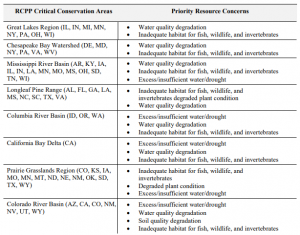On August 29, the EFC lead a webinar on finance and governance models for watershed management as part of the Environmental Finance Network Smart Management for Small Water Systems program. The webinar focused on source water protection as an effective way to protect public health and avoid the costs associated with contaminated drinking water. The webinar sought to answer three separate questions:
- What is watershed management?
- How do small water systems (under EPA guidelines, those serving under 10,000 people) benefit from watershed management?
- How can small systems participate in watershed management?
The answers to the first two questions are somewhat straight forward; watershed management is any strategy or set of strategies that positively influences land characteristics in a drainage area, and small systems benefit by avoiding costs; both monetary and abstract.
However, the answer to the third question is a bit more difficult. Small systems face unique challenges with respect to watershed management for the protection of drinking water; they often rely on purchased water, they have limited technical and financial resources, and they have limited ability to impact land use in the entirety of their water supply watershed. Watershed boundaries often cross jurisdictional boundaries, so the land use decision made by a neighboring government often heavily impacts the quality of the small system’s source water. This makes partnership extremely important. Small systems can partner with neighboring jurisdictions, enter into a shared source partnership, or collaborate with nonprofit conservation groups in order to have a greater impact on the quality of their source water.
Still, small systems face the challenge of funding source water protection efforts. For example, Raleigh, North Carolina raises over $3.5 million a year for land conservation in the Falls Lake Watershed with a watershed protection fee of $0.15 per 1,000 gallons. These funds go to the Upper Neuse Clean Water Initiative, a partnership among Raleigh, Wake County, the Clean Water Management Trust Fund, and multiple conservation organizations including the Triangle Land Conservancy. For a small system to have a similar impact, a watershed protection fee for them might need to be one or two orders of magnitude larger per 1,000 gallons. They simply cannot spread the costs of watershed protection over as large of a customer base. Therefore, small systems stand to benefit greatly from outside sources of funding, especially when such funding can support a water source protection partnership. One such source of funding for watershed protection partnerships is located within the 2018 Farm Bill.
2018 Farm Bill Funding
The 2018 Farm Bill allocates $300 million in funding in FY 2019 for the Natural Resource Conservation Service (NRCS), part of the Regional Conservation Partnership Program (RCPP). Over the next ten years, at least 10 percent the $4 billion allocated to the RCPP must go towards protecting drinking water sources.[1] Utilities can apply for this available funding in partnership with other organizations, such as conservation trusts, agricultural groups, and watershed organizations. Individual projects can receive up to $10 million, while the minimum funding amount is $250,000. You can view the NRCS funding announcement for FY 2019 here.
There are two pools of money from which the water quality projects may receive funding; critical conservation areas (CCA) and state/multistate fund pool. Fifty percent of the funding is earmarked for the CCA pool, and fifty percent is earmarked for the state/multistate pool. There are eight CCAs with specific priority resources concerns. Projects that address the priority resource concern within the CCA region are eligible for funding from the CCA pool.

The state/multistate fund pool is for projects that do not meet the requirements to receive funding from the CCA pool. Priority is given to projects that include a “manageable number of states.”
Eligible lead partners for all NRCS projects include water or irrigation districts and municipal water or wastewater treatment entities. Eligible activity types include land management/improvement/restoration, land rental, easements, and public works/watersheds activities or any combination of these items. Projects that benefit and include historically underserved farmers, ranchers, and landowners receive priority funding. NRCS water source protection projects are all intended to be a collaboration between water providers and farmers in a way that is cooperative and benefits everyone.[2]
There will be a webinar hosted by USDA on how to submit applications through the RCPP portal on October 17. The application deadline for FY 2019 funding is December 3, 2019.
Other funding for small systems
You can find and extensive list of additional funding opportunities for your water system in our funding matrices table on the Environmental Finance Network website.
[1] https://www.awwa.org/Resources-Tools/Resource-Topics/Source-Water-Protection
[2] AWWA video. https://www.youtube.com/watch?time_continue=189&v=kPEdoWgc4Gg
Evan Kirk has been with the EFC since 2016. He graduated from UNC in 2016 with a BS in Environmental Science and later earned a master’s certificate in GIS from the Department of Geography at UNC in 2017. Evan earned a masters in city and regional planning with a concentration in land use and environmental planning from UNC in 2019. In his current role as project director, he conducts applied research on water, wastewater, and stormwater finance topics and administers technical assistance and trainings for small systems.

